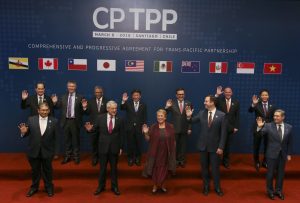China announced last month that it will be applying to join the Comprehensive and Progressive Agreement for Trade Pacific Partnership (CPTPP). It was quickly followed by Taiwan. With the U.K. having already applied for membership, the CPTPP has reached an important crossroads. Will it now allow itself to become a substantially larger free trade framework?
With China and Taiwan, that question is even more politicized than usual. Membership for both would be highly charged in domestic political terms. For that reason, accession is no easy task. So why apply for membership?
Beijing had already declared its support for free trade, and President Xi Jinping and Premier Li Keqiang have previously referred to accession, so in a sense it is established policy. The question, however, was the timing. At the 100th Anniversary of the Chinese Communist Party (CCP) on July 1, 2021, Xi declared that China has achieved a “moderately prosperous society in all respects,” a declaration that the problem of poverty has been eradicated. The next goal, which was not presented, is apparently “Common Prosperity.” By promoting new social economic reforms and joining the CPTPP, China’s intention may be to associate itself with that powerful free trade framework to promote common prosperity policies, including monopoly control. Moreover, by joining a free trade framework that does not include the U.S., China may be aiming to seize a leadership role in non-WTO global free trade frameworks, such as the Regional Comprehensive Economic Partnership (RCEP) and other free trade agreements.
China’s application is, in the first instance, a matter for the CPTPP chair. In 2021, this is Japan, to be followed by Singapore and New Zealand. These latter two countries are somewhat more open to China’s membership than Japan is.
As for Taiwan, it had previously given a number of indications that it would apply for CPTPP membership. The CPTPP is fundamentally an economic and trade framework under Asia-Pacific Economic Cooperation (APEC), and since Taiwan is a member of APEC as Chinese Taipei, it is procedurally possible for Taiwan to apply for CPTPP membership. However, China has become increasingly vigilant about the policies of Tsai Ing-wen’s Democratic Progressive Party administration, which Beijing sees as reinforcing Taiwan’s inclination toward independence, and it has been vocal in its criticism of Taiwan’s application for membership of the CPTPP, asserting that it violates the “One China Policy,” among other principles. Indeed, if China is able to join first, it will be able to oppose Taiwan’s accession. Even if it moves ahead of Taiwan with accession negotiations, China will be able to create difficulties by claiming that Taiwan is part of China.
For its part, Taiwan’s citizens are extremely sensitive when it comes to food issues, and referendums have suspended imports from Fukushima and other parts in Japan. That will make it a challenge for the Tsai administration to win the support of the various organizations associated with Japan’s primary industry. Moreover, with election season about to begin, the CPTPP application could be damaging to the Tsai administration. This is likely why Taiwan was hesitant to apply in the first place. Ultimately, however, China’s application was enough to prompt Tsai to move. Still, the negotiations represent a tricky path ahead.
For China, too, the negotiations will hardly be straightforward. In particular, state-owned enterprise reform and the elimination of domestic regulations are just two of a multitude of aspects that clash with China’s socialist system. The most valuable aspect for Beijing is to show the country and the rest of the world that it has applied for membership and is engaged in ongoing accession negotiations. That may also be true for the Tsai administration. For the time being, the fact that Taiwan has applied for membership and is moving forward with negotiations is important in and of itself.
When it comes to their position on the applications, CPTPP members are divided. The CPTPP operates on unanimous consent, so if even one country is against an application, membership will not be granted. Australia has already made clear it is opposed to China’s application. The Japanese government too, while welcoming Taiwan’s application, has reacted negatively to China’s application. Since the recent LDP presidential election in Japan will be followed by a Lower House general election, there is a tendency for debates over diplomacy and security to be somewhat simplistic and uncompromising. However, when the election season ends in November, Japan’s new government, which we know now will be led by Kishida Fumio, will have to come up with a new diplomatic strategy for not only to the U.S. and China, but for a tumultuous world in general.
What position will Japan take on the CPTPP? The U.S. is using climate change as an opportunity to cooperate with China. Likewise, if the Japanese government can seize this rare opportunity of China’s application to join the CPTPP to boost its dialogue with China, and if it can occasionally show a willingness to engage in dialogue and discussion about China’s socioeconomic system and other issues related to the CPTPP, the new Kishida government will enjoy significantly expanded scope for diplomacy. The same applies to Taiwan. China’s inevitable opposition to Taiwan’s accession means that Japan cannot ensure Taiwan’s accession alone. The Japanese government will need to engage in dialogue and coordination with Taiwan and other member countries, treading more cautiously and yet at the same time more boldly than ever before.

































